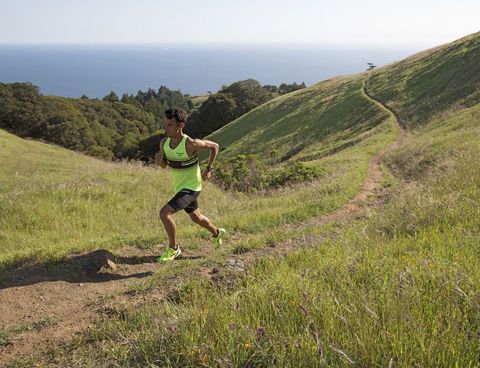I have zero arm swing right now and this didn't tell me a damn thing. I want to run again and it will look awful with all the spasticity I have in my left leg. I'll have to reread 'Teaching Me to Run' by Tommye-K. Mayer.
Or maybe from here:
4 Ways To Improve Your Running Arm Swing
Fix the elbows (around) the 90 degree mark
Keep your elbows fixed somewhere between 80 and 100 degrees. Make sure you’re not constantly bending and straightening your elbows as this will use up energy. Movement should be from the shoulder joint, not the elbow joint.
Keep your hands and shoulders relaxed
There can be a tendency to elevate the shoulders whilst running. This leads to unwanted tension so try to relax and keep your shoulders down. Clenched fists are also unnecessary, so try to keep your fingers loosely curled inwards with your thumbs on top (not down into the fingers). Your palms should face each other, rather than downwards.
Don’t over-rotate the torso
It’s not uncommon to see runners driving their hands too far across the body so that their torso over rotates. This leads to unwanted demands on the core and is an extremely inefficient way of running. To ensure you don’t do this imagine there’s a vertical line that runs down the middle of your body. Swing the arms back and forth so that your hands do not cross that line.
Drive back with the elbows, not forwards with the hands
A lot of runners create an arm swing by driving their hands forwards almost in a punching like manner. This however can become very tiring, so rather than focussing on driving the hands forwards, focus on driving the elbows backwards. This will feel a lot less exhausting and will encourage good posture and forward momentum.
The latest here:
Why your arm swing is so important to running and how to improve it
 Tandem
Tandem
The hips may be the body’s fulcrum and its centre of balance, but things that happen above the waist can, and do, also affect balance and drive. The body is all connected and balanced on top of itself: head, shoulders, hips, knees, ankles, feet. If you throw off that balance at the top, the supporting structures need to work harder to keep your body upright before they begin the task of pushing you forward.
And here, as with the hips, our lifestyles often compromise what our arms would naturally be doing if we lived as our ancestors did – using them for lifting, carrying, pushing, pulling and throwing – as well as for daily, extensive walking and running. You don’t run on your arms, but make no mistake, arms are important to running.
Coaches have long maintained the role played by the arms in enhancing the stride. Former elite runner Grant Robison finds it is easier for runners to focus on and change their arm movements than their leg movements. ‘Your arms are right by your face,’ says Robison. ‘They are easy to focus on. It is hard to think about where your foot is landing in relation to your hips. But your arms? You can make them go.’
No arm done
‘People think running is all about the lower body,’ says therapist Laura Bergmann of Evolution Performance and Rehabilitation Center in Virginia, US. ‘But because it is all connected, tightness up there affects down here. Tight lats and pectorals, as well as rounded shoulders, all inhibit your ability to have a tall spine when you run.’
‘Many problems attributed to hips are actually upper-body mechanical problems,’ says mobility expert and coach Brad Cox. Cox says most of us have some upper body problems that stem from excessive sitting and hunching.
(Related: How strong is your upper body?)
We hunch over computers – even more now that everyone uses a laptop. We hunch over phones and video games. ‘Sitting is just horrible,’ says biomechanist and marathon runner Rebecca Shultz. ‘Tech added on top is awful.’ And it isn’t just tech; we reach forward while driving, reading, writing and eating. Everything in our lives, it seems, prompts our upper body to be forward oriented.
No comments:
Post a Comment